ECU JAGUAR X308 1998 2.G Workshop Manual
[x] Cancel search | Manufacturer: JAGUAR, Model Year: 1998, Model line: X308, Model: JAGUAR X308 1998 2.GPages: 2490, PDF Size: 69.81 MB
Page 345 of 2490
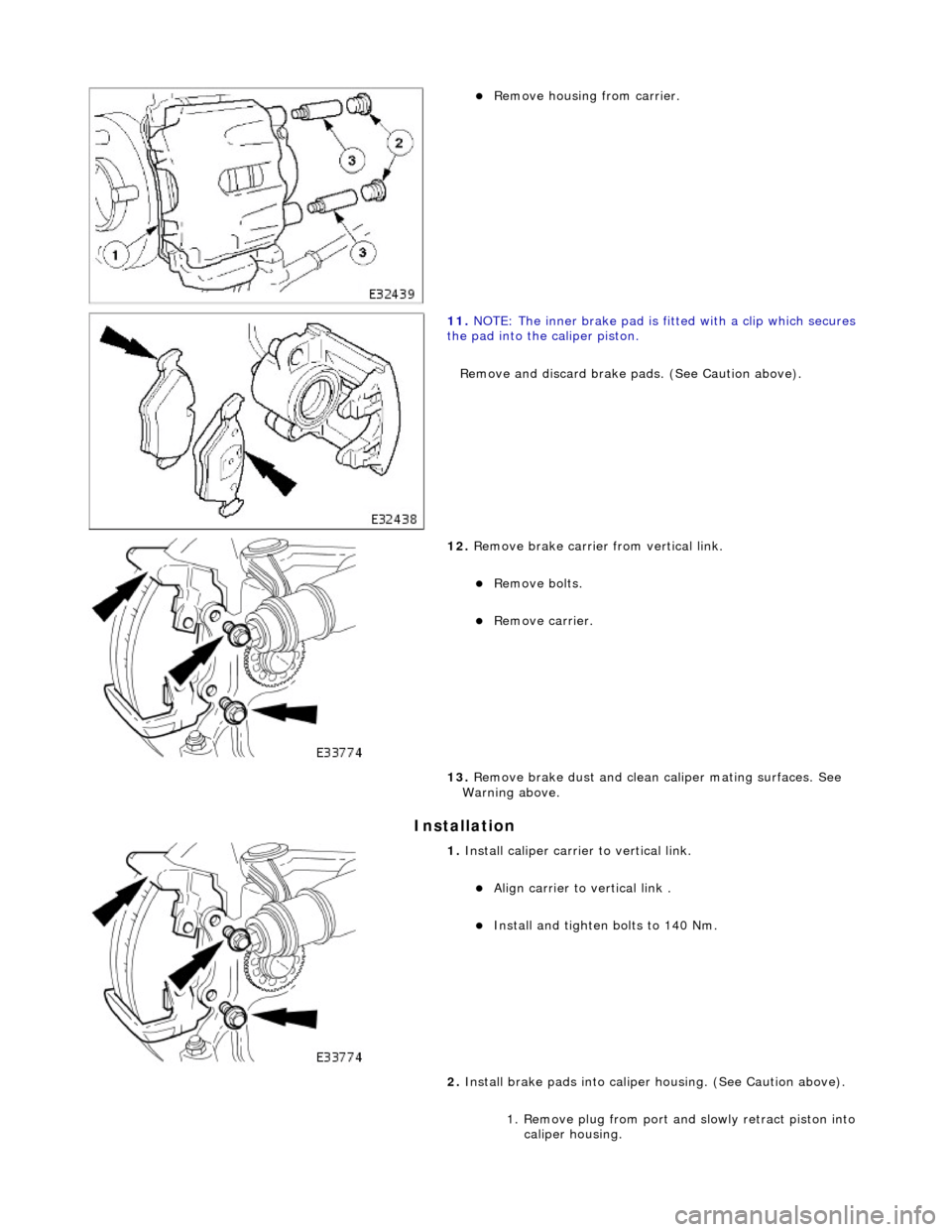
I
nstallation
R
emove housing from carrier.
11
.
NOTE: The inner brake pad is fitt ed with a clip which secures
the pad into the caliper piston.
Remove and discard brake pa ds. (See Caution above).
12
.
Remove brake carrier from vertical link.
Re
move bolts.
R
emove carrier.
13. Remove brake dust and clean caliper mating surfaces. See
Warning above.
1. Install
caliper carrier to vertical link.
Al
ign carrier to vertical link .
Install and tigh
ten bolts to 140 Nm.
2. Install brake pads in to caliper housing. (See Caution above).
1. Remove plug from port and slowly retract piston into caliper housing.
Page 347 of 2490

Front Disc Brake - Brake CaliperVehicles With: High Performance Brakes
Re
moval and Installation
Remov
al
S
pecial Tool(s)
Brake Pedal
Hold Tool
JDS 9013
1. WARNING: BRAKE DUST, IF INHALED CAN DAMAGE
YOUR HEALTH. ALWAYS REMOVE BRAKE DUST USING A VACUUM
BRUSH. DO NOT USE A COMPRE SSED-AIR LINE TO DISPERSE
BRAKE DUST INTO THE ATMOSPHERE.
• CAUTIONS:
Replacement of nuts and bolts: Various thread-locking
devices are used on nuts and bolts throughout the vehicle. These
devices restrict the number of ti mes a nut or bolt can be used.
See section 100-00 for information.
Remove brake fluid spillage immediately from paint work,
with clean water.
The Brembo caliper is aligned to the brake disc when it is
first installed to the vehicle, therefore, care must be taken not to
disturb this alignment. When removing the caliper; remove the
bolts that secure the anchor bracket to the vertical link only. DO
NOT loosen any other caliper bolts.
Open engine compartment and fit paint work protection covers
to fenders.
2. R
aise vehicle on a four-post lift.
3. Raise front of vehicle and support on stands. Refer to Section
100-02.
4. Remove front wheels. Refe r to operation 74.20.05.
5. NOTE
: The following three pictorial procedures must be
carried-out to minimize brake fl uid loss when disconnecting the
brake hose.
Open Left-Hand-Front and Left-H and-Rear caliper bleed nipples.
Connect
a bleed tube and co
ntainer to the calipers.
O
pen bleed nipples.
6. Depress and hold down brak e pedal at the specified
measurement using the special tool.
Page 349 of 2490

I
nstallation
4
. Remove brake pads.
11
.
CAUTION: Only remove the bolts securing the caliper
anchor bracket to the vertical link. Refer to caution above for
more information.
Remove caliper from vertical link.
Re
move bolts.
12
.
Remove brake dust and clean mating surfaces. See Warning
above.
1. Install
caliper to vertical link.
Install and tigh
ten bolts to 180 Nm.
2. CAUTI
ONS:
Retracting the caliper piston may cause the fluid reservoir
to over-flow. Remove brake flui d spillage immediately from paint
work, with clean water.
Note the condition of pins and 'R' clips and replace if
necessary.
Install brake pads into caliper.
Sl
owly retract caliper pistons.
1. Install pads.
Page 351 of 2490
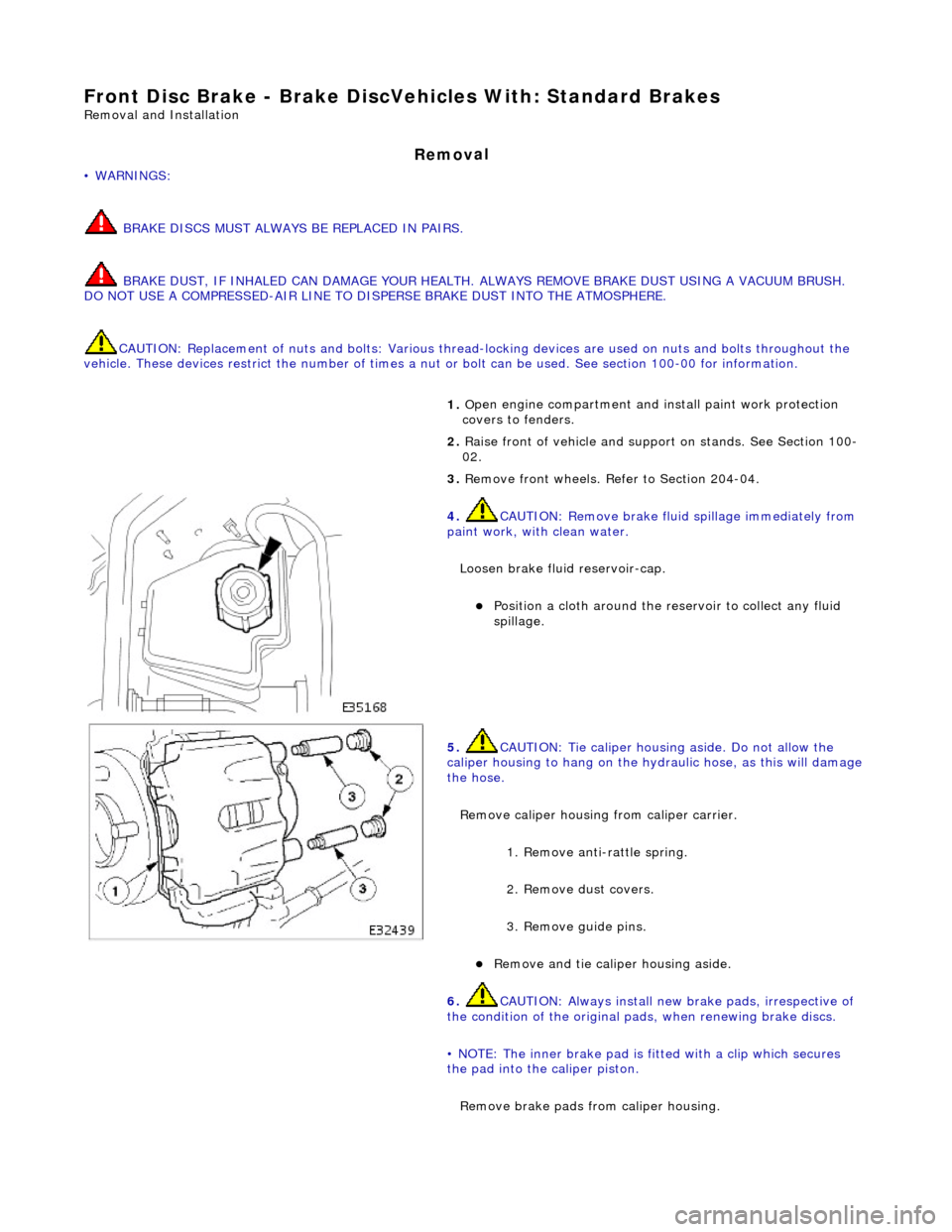
Front Dis
c Brake - Brake DiscVe
hicles With: Standard Brakes
Re
moval and Installation
Remov
al
• WAR
NINGS:
BRAKE DISCS MUST ALWAYS BE REPLACED IN PAIRS.
BRAKE DUST, IF INHALED CAN DAMAGE YOUR HEALTH. ALWAYS REMOVE BRAKE DUST USING A VACUUM BRUSH.
DO NOT USE A COMPRESSED-AIR LINE TO DI SPERSE BRAKE DUST INTO THE ATMOSPHERE.
CAUTION: Replacement of nuts and bolts: Various thread-locking devices are used on nuts and bolts throughout the
vehicle. These devices restrict the number of times a nut or bolt can be used. See section 100-00 for information.
1. O
pen engine compartment and in
stall paint work protection
covers to fenders.
2. Raise front of vehicle and suppo rt on stands. See Section 100-
02.
3. Remove front wheels. Re fer to Section 204-04.
4. CAUTI
ON: Remove brake flui
d spillage immediately from
paint work, with clean water.
Loosen brake fluid reservoir-cap.
Position a cloth around the
reservoir to collect any fluid
spillage.
5. CAU
TION: Tie caliper housing aside. Do not allow the
caliper housing to hang on the hydraulic hose, as this will damage
the hose.
Remove caliper housing from caliper carrier.
1. Remove anti-rattle spring.
2. Remove dust covers.
3. Remove guide pins.
Re
move and tie caliper housing aside.
6.
CAUTI
ON: Always install new brake pads, irrespective of
the condition of the original pads, when renewing brake discs.
• NOTE: The inner brake pad is fitted with a clip which secures
the pad into the caliper piston.
Remove brake pads from caliper housing.
Page 355 of 2490
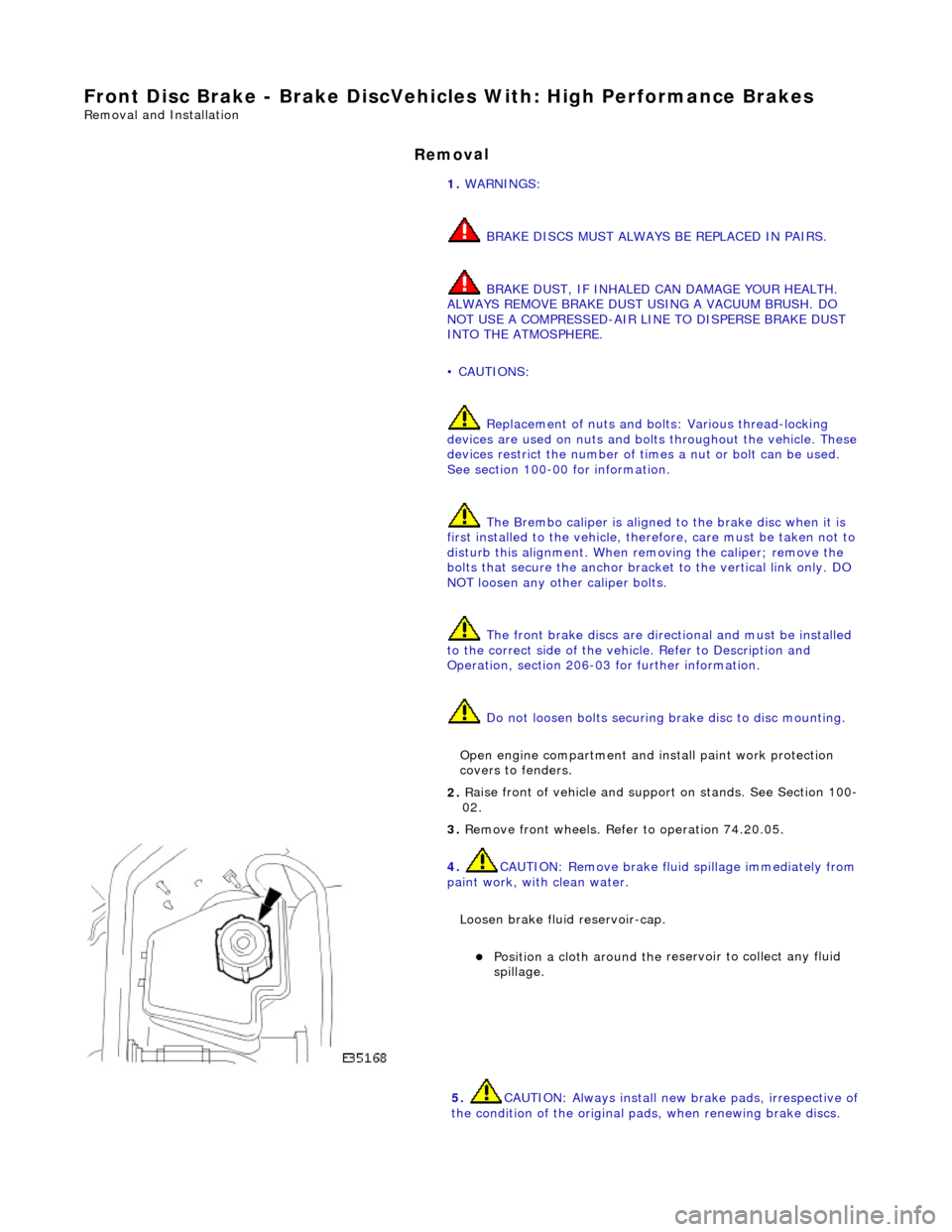
Front Dis
c Brake - Brake DiscVehicles With: High Performance Brakes
Re
moval and Installation
Remov
al
1.
WAR
NINGS:
BRAKE DISCS MUST ALWAYS BE REPLACED IN PAIRS.
BRAKE DUST, IF INHALED CAN DAMAGE YOUR HEALTH.
ALWAYS REMOVE BRAKE DUST USING A VACUUM BRUSH. DO
NOT USE A COMPRESSED-AIR LINE TO DISPERSE BRAKE DUST
INTO THE ATMOSPHERE.
• CAUTIONS:
Replacement of nuts and bolts: Various thread-locking
devices are used on nuts and bolts throughout the vehicle. These
devices restrict the number of ti mes a nut or bolt can be used.
See section 100-00 for information.
The Brembo caliper is aligned to the brake disc when it is
first installed to the vehicle, therefore, care must be taken not to
disturb this alignment. When removing the caliper; remove the
bolts that secure the anchor bracket to the vertical link only. DO
NOT loosen any other caliper bolts.
The front brake discs are dire ctional and must be installed
to the correct side of the vehi cle. Refer to Description and
Operation, section 206-03 for further information.
Do not loosen bolts securing brake disc to disc mounting.
Open engine compartment and in stall paint work protection
covers to fenders.
2. R
aise front of vehicle and suppo
rt on stands. See Section 100-
02.
3. Remove front wheels. Refe r to operation 74.20.05.
4. CAUTI
ON: Remove brake flui
d spillage immediately from
paint work, with clean water.
Loosen brake fluid reservoir-cap.
Position a cloth around the
reservoir to collect any fluid
spillage.
5. CAUTI
ON: Always install new brake pads, irrespective of
the condition of the original pads, when renewing brake discs.
Page 356 of 2490
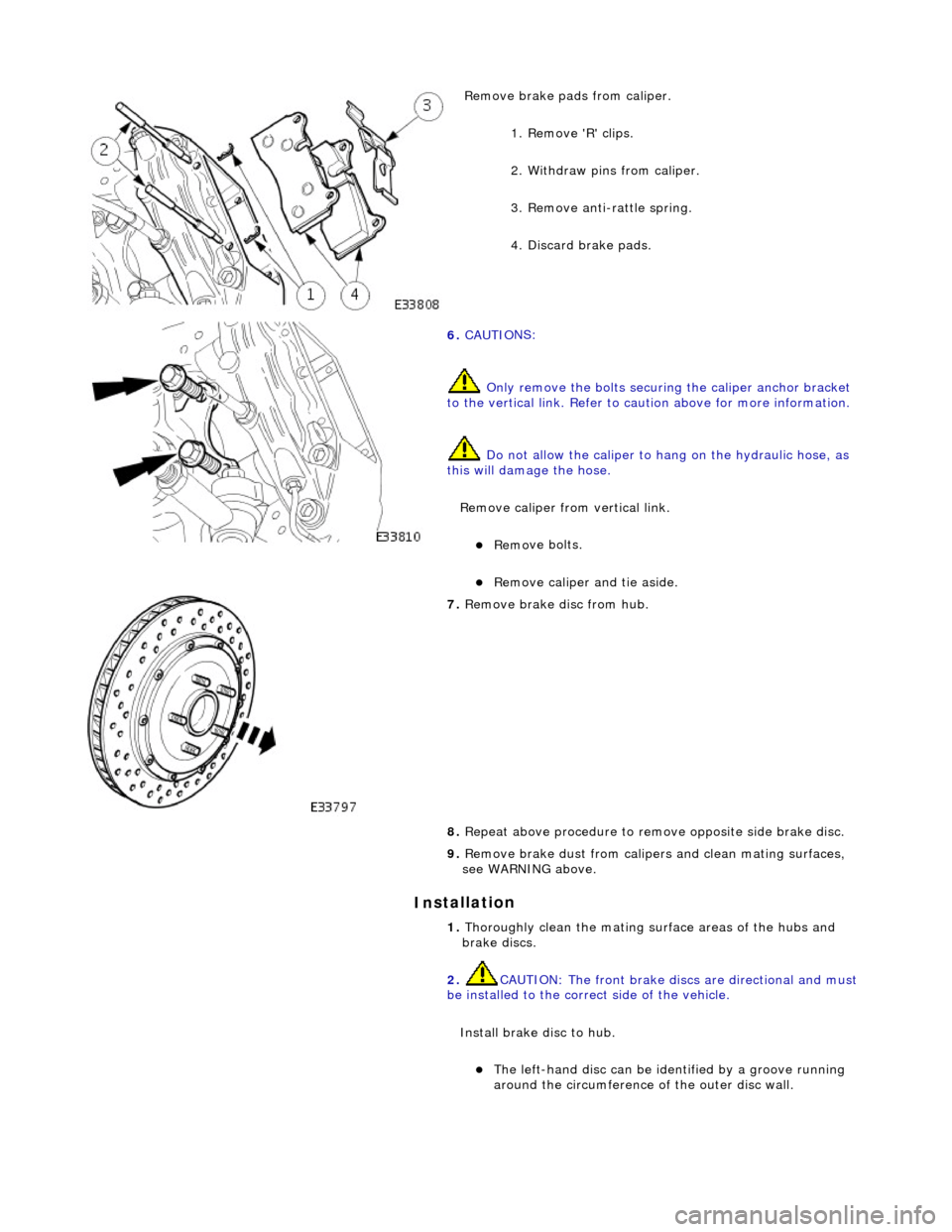
In
stallation
Remove brake pa
ds from caliper.
1. Remove 'R' clips.
2. Withdraw pins from caliper.
3. Remove anti-rattle spring.
4. Discard brake pads.
6. CAUTI O
NS:
Only remove the bolts securi ng the caliper anchor bracket
to the vertical link. Refer to ca ution above for more information.
Do not allow the caliper to hang on the hydraulic hose, as
this will damage the hose.
Remove caliper from vertical link.
Re mo
ve bolts.
Remove caliper and
tie aside.
7.
Remove brake disc from hu
b.
8. Repeat above procedure to remo ve opposite side brake disc.
9. Remove brake dust from calipers and clean mating surfaces,
see WARNING above.
1. Thoroughly clean the mating surface areas of the hubs and
brake discs.
2. CAUTION: The front brake disc s are directional and must
be installed to the correct side of the vehicle.
Install brake di sc to hub.
The left-hand disc can be iden tified by a groo
ve running
around the circumference of the outer disc wall.
Page 359 of 2490
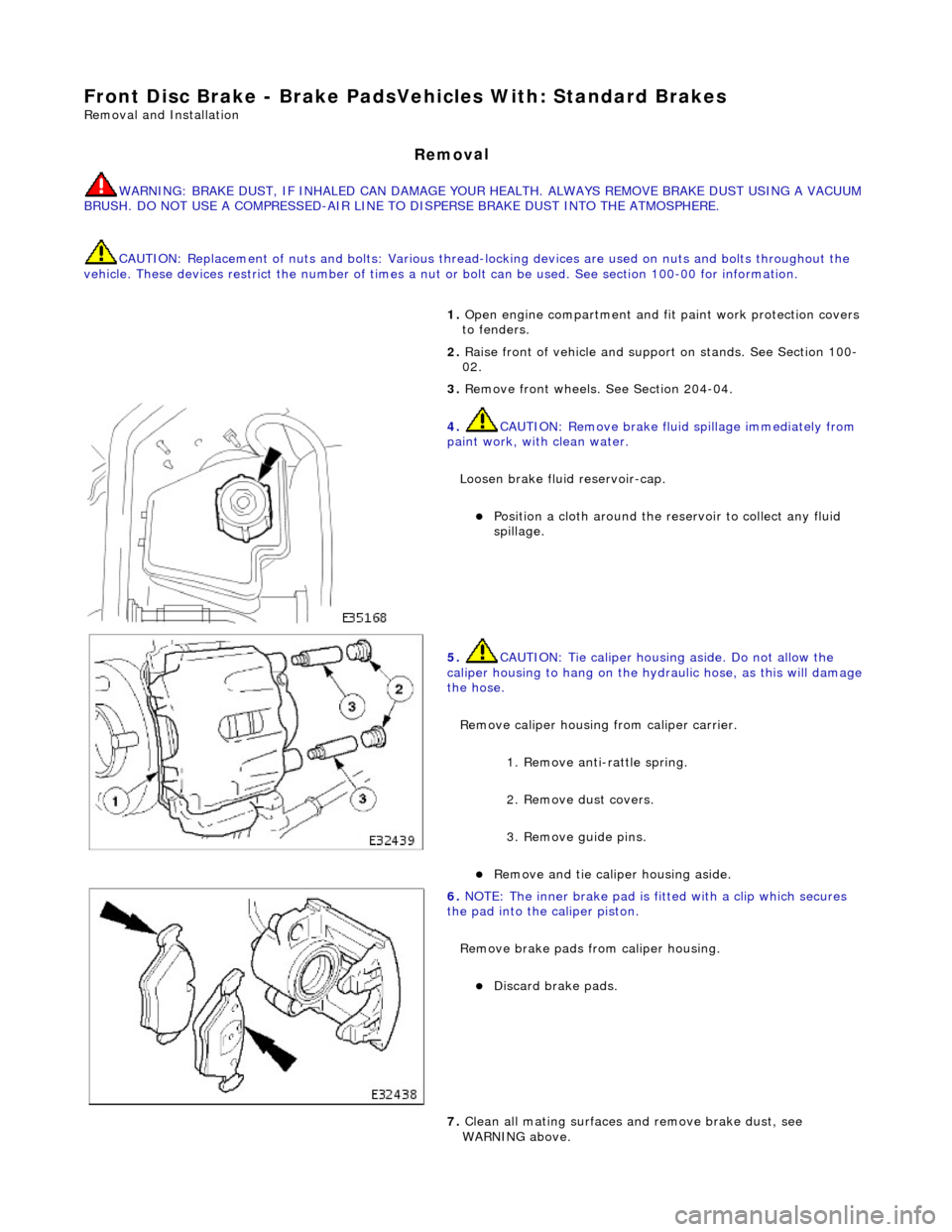
Front Dis
c Brake - Brake PadsVe
hicles With: Standard Brakes
Re
moval and Installation
Remov
al
W
ARNING: BRAKE DUST, IF INHALED CAN DAMAGE YOUR
HEALTH. ALWAYS REMOVE BRAKE DUST USING A VACUUM
BRUSH. DO NOT USE A COMPRESSED-AIR LINE TO DISPERSE BRAKE DUST INTO THE ATMOSPHERE.
CAUTION: Replacement of nuts and bolts: Various thread-locking devices are used on nuts and bolts throughout the
vehicle. These devices restrict the number of times a nut or bolt can be used. See section 100-00 for information.
1. O
pen engine compartment and fit
paint work protection covers
to fenders.
2. Raise front of vehicle and suppo rt on stands. See Section 100-
02.
3. Remove front wheels. See Section 204-04.
4. CAUTI
ON: Remove brake flui
d spillage immediately from
paint work, with clean water.
Loosen brake fluid reservoir-cap.
Position a cloth around the
reservoir to collect any fluid
spillage.
5. CAU
TION: Tie caliper housing aside. Do not allow the
caliper housing to hang on the hydraulic hose, as this will damage
the hose.
Remove caliper housing from caliper carrier.
1. Remove anti-rattle spring.
2. Remove dust covers.
3. Remove guide pins.
Re
move and tie caliper housing aside.
6.
NO
TE: The inner brake pad is fitt
ed with a clip which secures
the pad into the caliper piston.
Remove brake pads from caliper housing.
Discard
brake pads.
7. Clean all mating surfaces and remove brake dust, see
WARNING above.
Page 365 of 2490
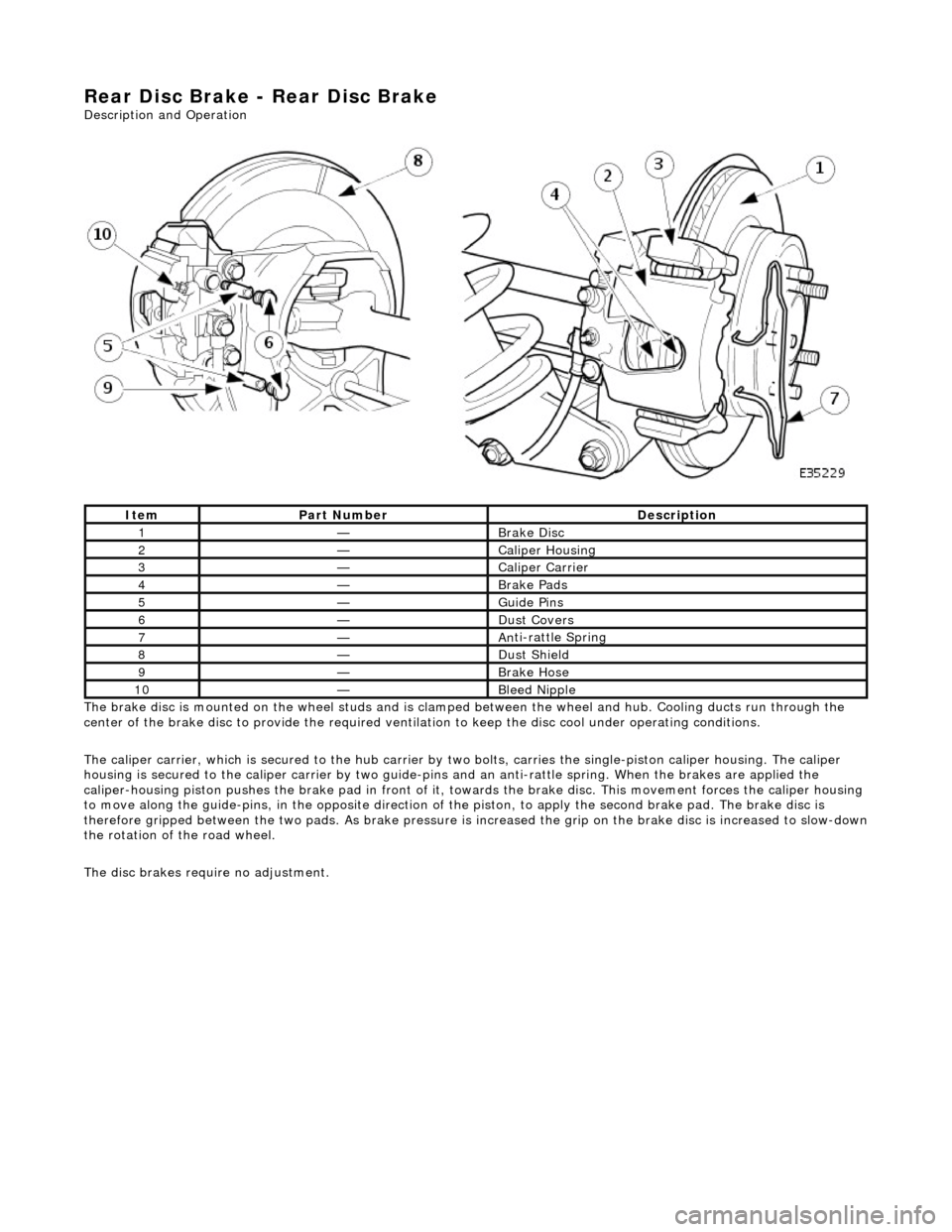
Rear
Disc Brake - Rear Disc Brake
Description an
d Operation
The brake disc is mounted on the wheel studs and is clamped between the wheel and hub. Cooling ducts run through the
center of the brake disc to provide the required ventilation to keep the disc cool under operating conditions.
The caliper carrier, which is se cured to the hub carrier by two bolts, carries the single-piston caliper housing. The caliper
housing is secured to the caliper carrier by two guide-pins and an anti-rattle spring. When the brakes are applied the
caliper-housing piston pushes th e brake pad in front of it, towards the brake di sc. This movement forces the caliper housing
to move along the guide-pins, in the oppo site direction of the piston, to apply the second brake pad. The brake disc is
therefore gripped between the two pads. As brake pressure is increased the grip on the brake disc is increased to slow-down
the rotation of the road wheel.
The disc brakes requ ire no adjustment.
It
em
Par
t Number
De
scription
1—B
rake Disc
2—Caliper Housin
g
3—Caliper Carrier
4—Brake Pad
s
5—Guide P
ins
6—Du
st Covers
7—An
ti-rattle Spring
8—Du
st Shield
9—Brake Hos
e
10—Bleed Nipp
le
Page 366 of 2490
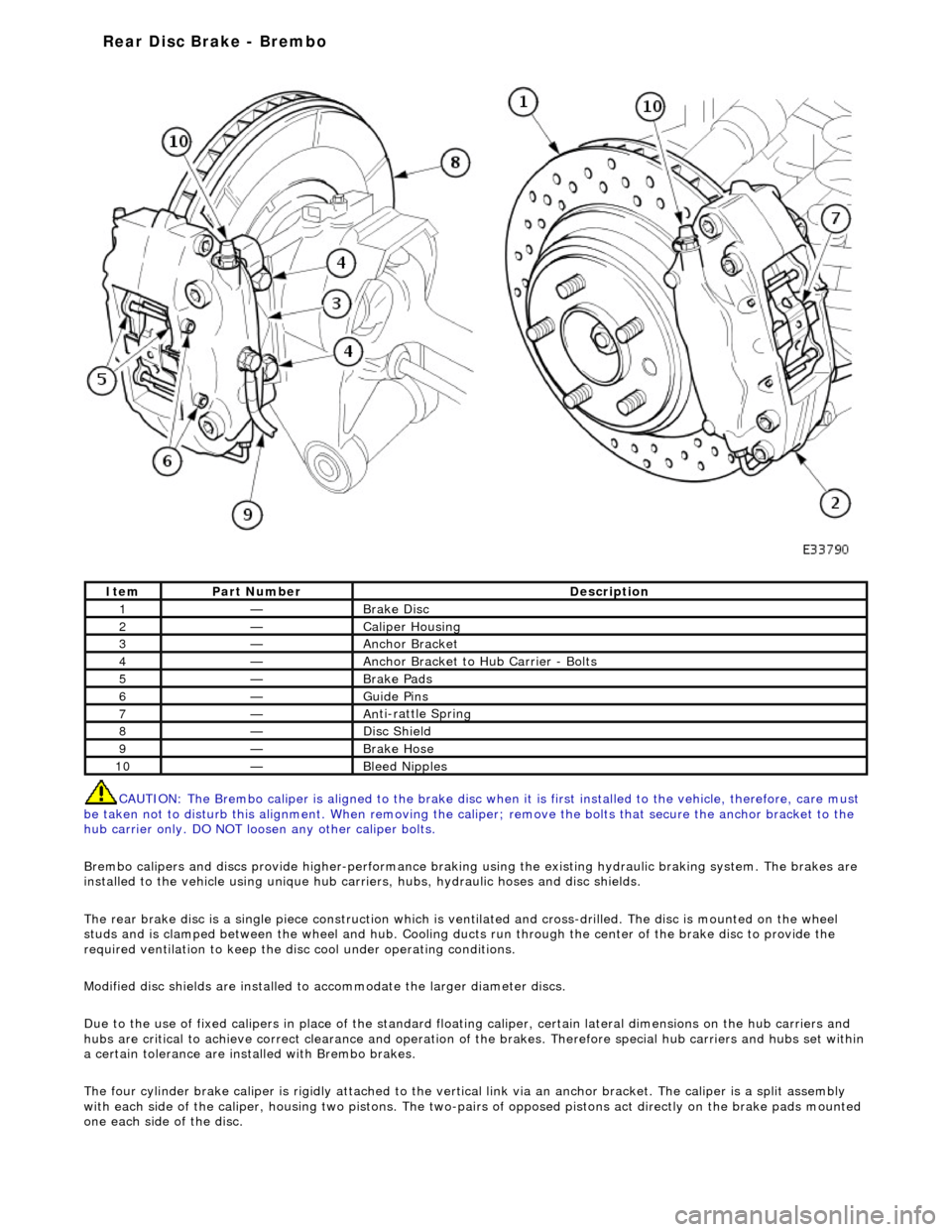
CAUTI O
N: The Brembo caliper is aligned to
the brake disc when it is first installed to the vehicle, therefore, care must
be taken not to disturb this alignment. When removing the ca liper; remove the bolts that secure the anchor bracket to the
hub carrier only. DO NOT loos en any other caliper bolts.
Brembo calipers and discs provide higher -performance braking using the existing hydraulic braking system. The brakes are
installed to the vehicle using unique hub carr iers, hubs, hydraulic hoses and disc shields.
The rear brake disc is a single piece co nstruction which is ventilated and cross-drilled. The disc is mounted on the wheel
studs and is clamped between the wheel and hub. Cooling ducts run through the ce nter of the brake disc to provide the
required ventilation to keep the disc cool under operating conditions.
Modified disc shields are installed to accommodate the larger diameter discs.
Due to the use of fixed calipers in place of the standard floating caliper, certain lateral dimensions on the hub carriers and
hubs are critical to achieve correct cleara nce and operation of the brakes. Therefore special hub carriers and hubs set within
a certain tolerance are inst alled with Brembo brakes.
The four cylinder brake caliper is rigidly attached to the vert ical link via an anchor bracket. The caliper is a split assembly
with each side of the caliper, housing two pistons. The two-pairs of opposed pistons act direct ly on the brake pads mounted
one each side of the disc.
It e
m
Par
t
Number
De
scr
iption
1—Brake D
i
sc
2—Caliper Housin
g
3—Anchor Bracke
t
4—Anchor Bracket to H
u
b Carrier - Bolts
5—Brake Pads
6—Guide Pi
ns
7—An
ti
-rattle Sprin
g
8—Di
sc
Shield
9—Brake Hos
e
10—Bleed Nipp
les
Rear Disc Brake - Brembo
Page 369 of 2490

7. Close bleed nipples on
both calipers.
Remove bleed tub
es and containers.
Tigh
ten front bleed nipple to 4-6 Nm.
Tigh
ten rear bleed nipple to 8-11 Nm.
8. Di
sconnect brake hose from
rear caliper housing.
Install plugs to caliper
and brake hose.
9. R
emove caliper housing from caliper carrier.
1. Remove anti-rattle spring.
2. Remove dust covers.
3. Remove guide pins.
4. Remove housing from carrier.
10. NOTE: The inner brake pad is fitt ed with a clip which secures
the pad into the caliper piston.
Remove and discard brake pa ds. (See Caution above).